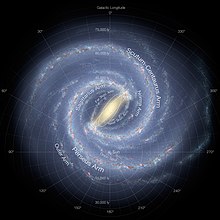Interstellar space

The interstellar space ( Latin inter stellas , 'between the stars') is the distant space within a galaxy . The astrospheres , the space around the stars , are interspersed in this area . Inside the astrospheres lies the denser interplanetary space filled by the stellar wind , outside the galaxies lies the thinner intergalactic space .
The boundary between interplanetary and interstellar space is defined by the astropause of the respective stars. In the case of the sun, this is the heliopause of the heliosphere , at which the solar wind is stopped by the interstellar medium . This limit area is approximately 120 astronomical units (AU) (18 billion kilometers) from the sun; that is four times the mean distance between the sun and Neptune .
The Voyager 1 space probe was the first human-made object to emerge from the heliosphere on August 25, 2012 and continues to send measurement data to Earth. Voyager 2 followed on November 5, 2018.
Similarly, the boundary between interstellar and intergalactic space is defined by an outwardly driven galactic gas flow, which forms a boundary layer with the intergalactic matter in the outer area of the galaxies.
Travel through interstellar space is a popular topic in science fiction . Such projects have not yet been technically feasible due to the enormous distances involved for mankind.
literature
- Joachim Krautter et al .: Meyers Handbuch Weltall , Meyers Lexikonverlag, 7th edition 1994, ISBN 3-411-07757-3
- Arnold Hanslmeier : Introduction to Astronomy and Astrophysics , Spectrum Akademischer Verlag, 2nd edition 2007, ISBN 978-3-8274-1846-3
Individual evidence
- ↑ Michael Odenwald: Space probe "Voyager 1" has left the solar system. In: focus.de. September 12, 2013, accessed September 14, 2013 .
- ↑ Sean Potter: NASA's Voyager 2 Probe Enters Interstellar Space. In: NASA .gov. December 10, 2018, accessed December 10, 2018 .